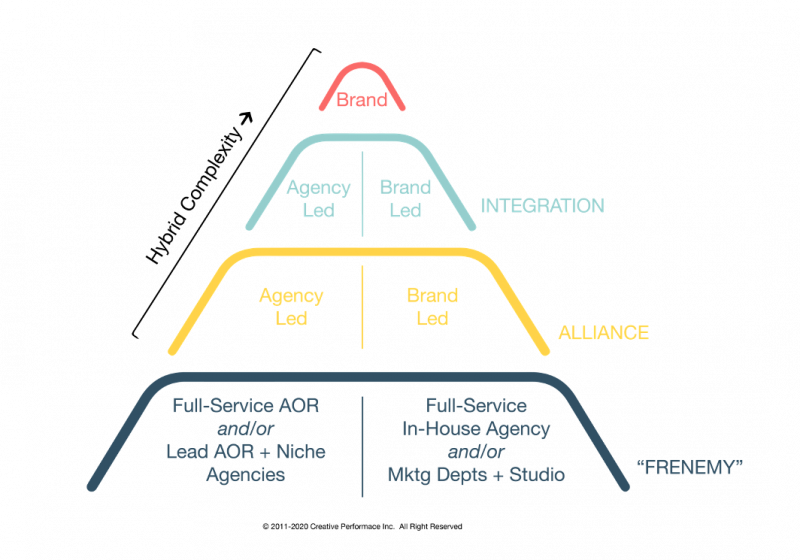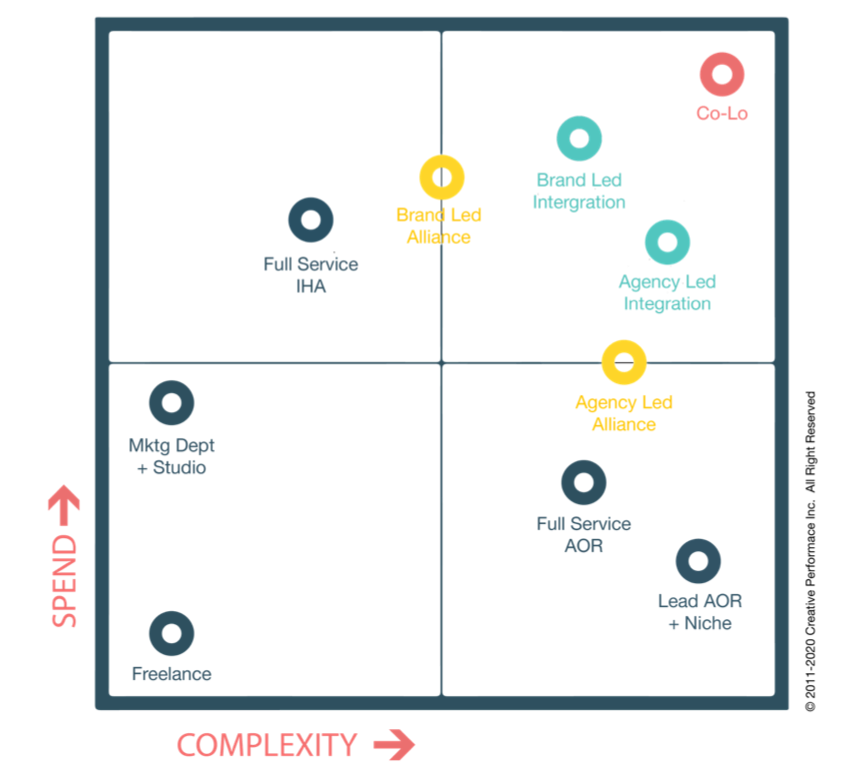Excerpts from Henry Stewart Seminar with Vanessa Vollum Edwards
Welcome to the final installment of the Hybrid Agency Tango! As a quick reminder, the 1st blog post focused on an introduction to the Hybrid Pyramid, with subsequent blog posts covering the Agency Led track – highlighting more traditional and familiar relationship models between Brands and their Agency partners – and the Brand Led track, which highlighted emerging partnership models between Brands and their Agency partners.
If you are just joining us, below is a visual representation of the Hybrid Agency Pyramid, and a brief description of the evolution of IHA from 1.0 to Hybrid.
- 1.0 focused on cost, speed, control and media unbundling
- 2.0 focused on multi-channel complexity, MarTech, data security and 360° analytics
- Hybrid focused on evolving beyond “Frenemies” into Alliance, Integration & Co-location

Introducing the Pinnacle of Hybrid
In this final blog, we’ll move beyond the Brand or Agency Led Integration Models to discuss the pinnacle of Hybrid: Co-Location.
Co-Location (Onsite)
By Co-Location, I do not mean the old school model of having a single Account Director onsite working with the marketing directors and managers to “get more business.” What I mean is the addition of Co-Location to either the Agency Led or Brand Led Integration Models previously discussed. This model of Co-Location is not designed around cost-savings; it’s about bringing together the best of the Agency world and the best of the Brand to produce the best marketing programs.
This can take on multiple forms, but at its core, Co-Location involves having a dedicated onsite team made up of in-house and agency resources who collaborate daily. The onsite Co-Location model aids in increasing strategy alignment + collaboration, improving the effectiveness of teams and attracting better talent.
However, while Co-Location is the pinnacle of the pyramid, it’s not right for everyone. This model only makes sense for large, global brands with the most complex marketing and extremely large spends. It’s for brands who spend a lot of money with their agencies and who have the pull to get agency resources onsite full time to increase integration for improved ROI. Really, it’s for the lucky few.
Here are some perspectives and insights from some of those ‘lucky few’ who’ve had success with this Co-Location model:
- “MRM//McCann has a division called Inside through which about 10 percent of the agency’s employees are embedded with clients, but parent IPG does not openly promote the division.” Insider, Nov 2, 2019
- “…the need for better agency-client transparency, closer collaboration with client stakeholders in different areas of their businesses, and the need to connect their data sources. There is greater demand for brands to bring agencies closer, either through agency co-location, or establishing bespoke, onsite multi-disciplinary teams.” WPP, Nov 2017
- “Much of the conversation is about new agency models: procurement demands more efficient solutions; chief marketing officers require better performance; shareholders need growth; agency heads want deeper relationships; planners want more access to data, and so on. Taking some of the agency solution onsite is part of the answer.” WPP, Nov 2017
- “An on-site team offers dedicated, focused resource, and integration with the brand’s marketing teams allows for the absorption of expert brand knowledge. With your agency feet (not miles) away, closer communication leads to more ‘right first time’ results.” The Drum, July 2017
- “Pulse Creative, a WPP-backed communications agency for News UK, comprises 70 creative experts from various teams like CHI & Partners, m/SIX, Mindshare, The BOX, and Wunderman. Located onsite, they have crafted campaigns enabling News UK to streamline their marketing operations through agency consolidation. Creativity did not take a back seat either – Pulse Creative has won five D&AD Pencils, the top creative award in the UK.” GEP, August 2017
As an evolution of the Agency Led or Brand Led Integration Models, Co-Location creates a cohesive team with bi-directional access to agency experts and internal stakeholders, while improving strategy + ideation and increasing speed-to-market. In addition, this Co-Location model reduces the complexity of project managing work through the Brand and Agency sides, increasing the overall agility of the partnership.
However, this is by far the most expensive model and only works for large global brands with the most complex marketing and biggest spends. In addition, this model can be extremely difficult to implement operationally and culturally…and a big risk if it doesn’t work properly.
GENERAL FRAMEWORK:
- Old-school vs. New-school mentality
- Evolution of Agency Led Integration or Brand Led Integration
- Prompted by need for tighter integration to improve ROI
- Includes AM, PM, Creative, Channel Strategy/Execution, etc.
- Reserved for the lucky few
PROS:
- Bi-directional access
- Improved strategy + ideation
- Ease of project management
- Improved agility and response time (speed-to-market)
- Agency gains increased knowledge of brand
CONS:
- Most expensive model
- Most difficult to implement
The Hybrid Quadrant
Finally, let’s jump into this image of the Hybrid Tango displayed as a “Magic Quadrant.”
If this is the first time that you’ve heard any of this content via these blog posts, it may be a little bewildering to figure out where you fall today…and where you SHOULD be as you move towards Hybrid. So, we created this Magic Quadrant image to help you, where the 2 axes are Marketing Spend and Marketing Complexity.
I’ve found that the higher the Marketing Spend, the bigger the value is for Brands to bring work in-house. Likewise, I’ve found that the higher the Marketing Complexity, the better it is for Brands to lean on their Agency partners.
Based on this idea of Marketing Spend vs. Complexity, I’ve populated the Magic Quadrant with all of the models discussed throughout these blog posts. For example, a Brand with light complexity in their marketing and not a lot of marketing spend may fall into one of the models in the bottom left corner of the Quadrant – whereas a Brand with large marketing budgets and very complex, integrated initiatives may find themselves best served by one of the models in the top right corner.
So, based on how your organization is structured today, where do you fall now – and based on what you’ve read thus far, where do you want to be?

Key Takeaways
- BRAND/AGENCY relationships continue to evolve.
- More and more work is being brought in-house.
- BRANDS can’t do it all themselves.
- AGENCIES must embrace Hybrid.
- Finding the right Hybrid partner is challenging.
- Obviously, one size does not fit all.
- The risk is greater, but so are the rewards.
- The Hybrid space is unsettled territory.
Thank you!
Phew, that was a lot of content! I hope you found value in this blog series covering the many aspects of The Hybrid Tango. My goal with this blog series was to weave together a lot of information from a variety of resources and combine it with my own experiences.
If you can walk away with one thing, it’s that I believe that In-House is here to stay and that it is going to evolve into Hybrid over time. With that said, there isn’t one size of Hybrid that fits all, and it’s important to know what’s right for you – and I hope I’ve provided examples of the various models that might be a good fit for your organization!
– Vanessa
© 2020 Creative Performance Inc., All Rights Reserved
